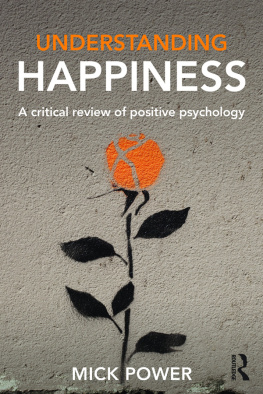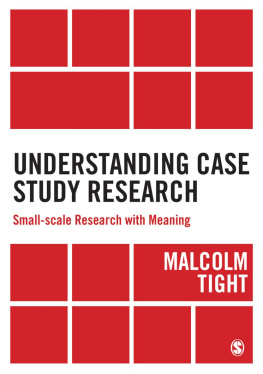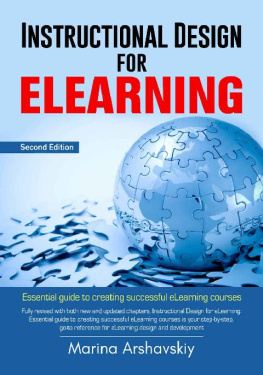A Designers Log
Case Studies in Instructional Design
by Michael Power

2009 Power, Michael
Published by AU Press, Athabasca University
1200, 10011 109 Street
Edmonton, AB T5J 3S8
A volume in the Issues in Distance Education series,
edited by Terry Anderson, Ph.D.
ISSN 1919-4382 Issues in Distance Education Series (Print)
ISSN 1919-4390 Issues in Distance Education Series (Online)
Library and Archives Canada Cataloguing in Publication
Power, Michael
A designer's log : case studies in instructional design / by Michael Power.
Translation of: Le conseiller pdagogique rflexif.
Includes bibliographical references.
ISBN 978-1-897425-61-9 (Print)
ISBN 978-1-897425-46-6 (Electronic)
1. Universities and colleges--Curricula--Planning. 2. Instructional systems--Design. 3. Curriculum planning. 4. Universities and colleges--Curricula--Planning--Case studies. 5. Distance education.
I. Title.
LB2361.P6813 2009 378.1'99 C2009-904552-4
Printed and bound in Canada by Marquis Book Printing
Please contact AU Press, Athabasca University at for permission beyond the usage outlined in the Creative Commons license.
I wish to thank Dr. Claire Lapointe, Universit Laval, for her unwavering support and her critical appraisal of this project as it evolved from a need, to a desire, to an idea and finally to an actual book. Id also like to recognize Professor Bernard Nadeau from Universit de Moncton who, over the years, has been a stalwart friend in need/indeed and an educator with a flair for intuition. Finally, this book would have never seen print without the unconditional support from my friend and colleague Dr. David Kaufman of Simon Fraser University.
- Michael Power
Contents
Foreword
The transformation of a traditional learning institution into a dual-mode institution offering courses on-campus as well as online is not a task for the faint at heart. What has to be appreciated is that subject matter experts, used to teaching in a classroom, face a daunting challenge when requested to teach at a distance or online. Indeed, only a few have ever systematically planned their courses. Yet systematic planning is just what is needed to be a successful teacher.
To implement online learning in a traditional institution, we have to adopt a design model which is both easy to understand and easy to use, namely because faculty generally do not have a lot of time to dedicate to this task. In this book, the course design model proposed by Dr. Power is flexible and represents an important step in making course design both doable and affordable.
There are a lot of course design models out there but I have to admit that there are very few that are as easy to use as that presented by the author. What makes this model truly original is that it involves close interaction between the subject matter expert (professor) and the instructional designer (ID). What I find of particular interest is that it involves the ID planning a course directly online with the professor at his/her side and implementing existing and relevant elements of the professors on-campus course. The ten case studies presented in Dr. Powers book amply demonstrate this faculty-based practices approach indicative of his model.
Books dealing with instructional design usually propose a theoretical model and include a few examples to demonstrate applicability. Dr. Power, however, has chosen to present actual case studies demonstrating practices that work, and then adds theoretical underpinnings. That is, I believe, what is of greatest interest in this book. The cases presented, being very detailed, actually walk us through just what happened and how it happened. That is why I think that this book will be exceptionally useful to anyone working in this area. In this regard, the contribution the author has made to the general field of instructional design is important.
Instructional designer culture is not limited to theoretical knowledge or design-related skills alone. They must acquire and demonstrate mastery of specific and requisite interpersonal skills and attitudes that many of us tend to gloss over. This is yet another strong point of this book; I am particularly impressed by the flexibility shown by the author in dealing with the various professors he encountered. Possessing such skills and attitudes or not can often make all the difference between the success of the failure of an instructional design project for online learning. By reading this book, Im confident that both practicing and future instructional designers will understand the importance of tact and attitudes de tolerance and tenacity, attributes which are so important when dealing with subject matter experts.
Moreover, Im convinced that these case studies presented by Dr. Power will not only be useful to instructional designers who use his model to design online courses but to all instructional designers in whatever they design. As a matter of fact, I observed that several of the cases described by the author refer to many frequently encountered problems in instructional design.
It is therefore with great pleasure that I recommend Dr. Powers book to all those who are interested in course design and, particularly, in online course design in dual-mode universities.
Dr. Robert Brien
Laval University
Quebec City
Preface
"The first was never to accept anything for true which I did not clearly know to be such; that is to say, carefully to avoid precipitancy and prejudice, and to comprise nothing more in my judgement than what was presented to my mind so clearly and distinctly as to exclude all ground of doubt."
Excerpt from Discours sur la mthode by Ren Descartes
I first read the Discours sur la mthode when I was a community college student and I have to admit that, at the time, it did not have much of an effect. But over time, in the way a constant drip can erode even the hardest granite, it came to permeate my thinking. What Descartes said, in just a few words, seems to me to be the core of the scientific method, as it is based on the surest of foundations, the personal observation of phenomena. To my mind, Descartes lays the responsibility of seeing with our own eyes and hearing with our own ears, each and every one of us. To doubt is a reflex, the lack of which would imperil any scientific pursuit. Of course this does not mean that one should automatically reject what someone is telling us. Certainly not. But it does not mean we should accept it at face value either. A state of wariness is, I believe, permanently warranted, the duty to question one's understanding of a phenomenon, as well as that of others, is a ceaseless task.
Now that I have brazenly attempted to associate myself with one of science's brightest lights, please allow me to explain how this modest manuscript has the least to do with the monumental work of our august predecessor. When I began the research study on developing an appropriate dual-mode design model documented in the present log, I thought I had the world by the tail. I had over 12 years' experience in the field of instructional design in higher education, plus excellent instruction during my studies toward a Master's degree, as well as all the resources I thought I needed to complete the project at hand. I really could not see any difficulty, not a cloud on my horizon. It was thus, head-first and with a mind full of misplaced certitude, I undertook this journey of designing courses, first for distance education and subsequently for online learning.
It was not long before I started to see that all was not right with my world. Actually applying the instructional design theories I had diligently learned in graduate school when I began working with subject matter experts (SMEs) was harder than I could have imagined. In the field, I was confronted with design challenges of the like I had never before experienced. I found myself asking "What (on earth) can I base this or that design-related decision on?" The illustrious ADDIE approach, upon which is based a huge segment of design literature (Gustafson & Branch, 1997) was, surprisingly, of little or no use to me. I felt like I had just landed on a new planet without a map and without knowing the language of the inhabitants. Man, what a surprise! It was precisely then that Descartes' famous words started ringing in my ears and it seemed that I truly understood them for the first time: "de ne recevoir jamais aucune chose pour vraie que je ne la connusse videmment tre telle" (never to accept anything for true which I did not clearly know to be such).















